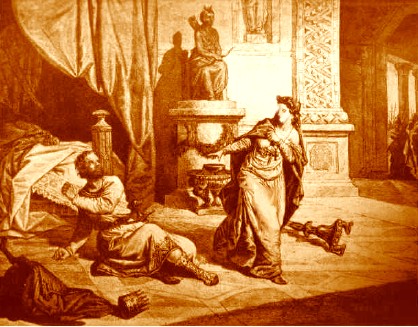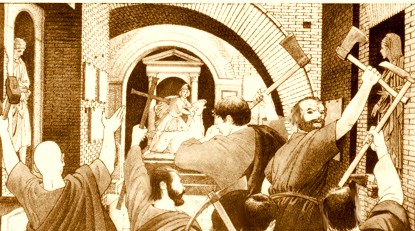![]()
![]()

THE FIRST CHRISTIAN NATION

KHOR VIRAP MONASTERY BUILT OVER THE DUNGEON WHERE
ACCORDING
TO THE LEGEND ST. GREGORY WAS IMPRISONED. THE MONASTERY BUILT
IN THE FOURTH CENTURY WAS REBUILT IN THE XVIITH CENTURY.
Written by Gevork Nazaryan
King Trdat III, initially at the beginning of his reign had a very negative and hostile stance toward Christianity, viewing it as a weak religion of the masses and not the Armenian warrior aristocracy. Two of the prominent Christian virgin martyrs were St. Gayanē and St. Hripsimē who along with their dozens of maidens from their convent were martyred by the order of the King.

JULIANO ZASSO (1833-1889). ST. HRIPSIMĒ
WRESTLES KING TIRIDATES TO THE
THE GROUND. ACCORDING TO THE ACCOUNT OF AGATHANGELOS KING TIRIDATES
LUSTED AFTER ST. HRIPSIMĒ AND FORCEFULLY
BROUGHT HER TO HIS COURT.
THE MARTYRED VIRGIN DENIED ALL OF THE ADVANCES OF THE KING AND
WAS SO OVERWHELMED WITH THE HOLY SPIRIT THAT SHE WAS ABLE TO
LIFT AND THROW THE KING TO THE FLOOR. ST. HRIPSIMĒ
ALONG WITH
ST. GAYANĒ AND ALL THE OTHER CHRISTIAN
CONVERTS WAS MARTYRED
FOR HER STOIC CONVICTION.
But by the end of the third century a new underground movement was becoming more evident headed by Gregory. As we saw, the later Catholicos to be was the son of the accused assassin of King Xosrov Aršakuni, father of King Trdat III. St. Gregory after his preaching activity in Lesser Armenia, on the western side of the Euphrates river came to Vałaršapat, the capital of Greater Armenia. Upon his arrival in Vałaršapat, St. Gregory was promptly arrested by the royal guards on charges of undermining the authority and order of the King and the State. According to the account told by contemporary historian Agat'angełos, King Trdat imprisoned St. Gregory by placing him in a dungeon of Khor Virap (literary -- deep pit). Christianity in the late third century was viciously persecuted and put down by the monarchs throughout the ancient world who viewed it as a pacifist religion that rejected the here and now and promised redemption in the then and there. Trdat being a close friend and an ally of the Roman Emperor, Diocletian, also pursued similar policy of suppressing the spread of Christianity. Gregory remained imprisoned for twelve long years in the dark chambers of Khor Virap. Things quickly began to change in the year 297. Trdat, having seen the true nature of his "best friend" Diocletian, who in 297 invaded Armenia and even behind Trdat's back signed a treacherous treaty with the hated rivals the Sassanians, was furious. Another IVth century historian Faust Buzand tells us that Trdat, soon after was sickened with "madness" turning into a "wild boar." As the story goes, in desperation he sought the help "of that wizard who is still alive in that pit" -- as one of court advisors told the King. Trdat ordered the release of St. Gregory who after a quick prayer cured Trdat who turned back into a human form. The story, written by Buzand shows the rapid change from persecution of Christianity, to toleration, acceptance and eventually advocacy.

C. JACOBI. ST. GREGORY THE ILLUMINATOR EMERGES FROM THE XOR
VIRAP
DUNGEON NEAR ARTAXATA. KING TIRIDATES III KNEELS IN SUBMISSION.

THE ALTAR OF ST. GREGORY THE ILLUMINATOR ON SAN LAZZARO ISLAND,
VENICE --
AN INTERNATIONAL LEARNING CENTER OF AND FOR ANCIENT ARMENIAN CULTURE
AND CIVILIZATION -- THE HOME OF THE MONASTIC HEADQUARTERS OF THE WORLDWIDE
MEKHITARIST ORDER [THE MEKHITARIST FATHERS FROM THE XVIIITH CENTURY
SPEARHEADED THE NATIONAL AWAKENING THROUGH EDUCATION AND ENLIGHTENMENT
BY ESTABLISHING THE FIRST DE FACTO NATIONAL ACADEMY OF SCIENCES
THAT PRODUCED SOME OF THE LEADING INTELLECTUALS OF THE ERA
INCLUDING PROMINENT ARTISTS, SCIENTISTS, ARCHITECTS,
WRITERS, POETS AND THINKERS] IN SAN LAZZARO.
DEPICTING A CLASSICAL PAINTING OF THE BAPTISM OF KING TRDAT III,
THE ROYAL FAMILY AND THE COURT BY ST. GREGORY.
In 301, St. Gregory officially baptized king Trdat III along with the members of royal court and upper class. Trdat issued a decree by which he granted the right to start the conversion of the entire heathen Armenia. Unfortunately, this process of converting Armenia had with the positive a negative impact on the cultural rich pre-Christian heritage of Armenia. Many temples, written mehian [Mihrian - named after Armenian Solar God Mithras] manuscripts, and other priceless cultural monuments were obliterated and destroyed by the fanaticism of the newly converted followers of St. Gregory. So the Word was spread with the Sword unfortunately. Often hunting down and killing pagan high priests, who at that time in the temples kept the ancient wisdom traditions of Armenia that went back to time immemorial - a lot of knowledge was forever lost. Many new churches, including the Mother Church of Holy Echmiadzin [completed in 303] were erected right on the remnants of destroyed fire and solar temples - whose very important locations on lay lines, vortexes and crisscrossing grids were specifically chosen by the ancient Armenian master builders.

THE DOWNSIDE OF THE SPREAD OF CHRISTIANITY WAS THE DESTRUCTION OF
THE ANCIENT AND RICH HEATHEN [FROM ETHNOS...NATION-AL]
HERITAGE OF ARMENIA INCLUDING COUNTLESS SACRED BEAUTIFUL
MITHRĆAI OF MIHR-MITHRAS THE GOD OF
LIGHT AND TRUTH.
THE INITIAL FANATICISM OF THE NEW CHRISTIAN CONVERTS OFTEN LED BY
OUTSIDE CLERGY WOULD EVENTUALLY
GIVE WAY TO INCORPORATING THE SACRED RITES, RITUALS AND SYMBOLS
OF THE SUN GOD INTO NEWLY FORMING HOLY APOSTOLIC CHURCH OF
ARMENIA WHICH IN MANY WAYS PRESERVED AND LATER
ENRICHED THE NATIONAL HERITAGE.

THE MOTHER CATHEDRAL - FIVE DOMES - FOUR AROUND ONE
CENTER.